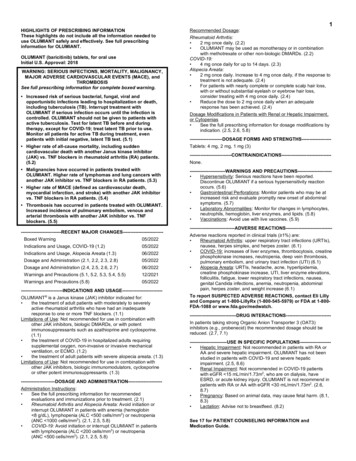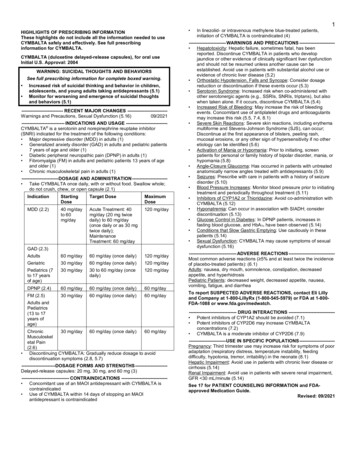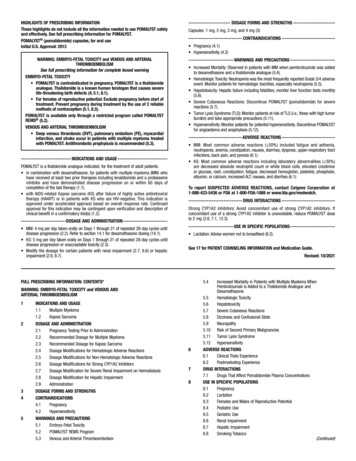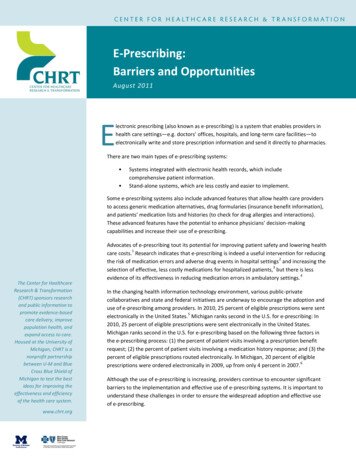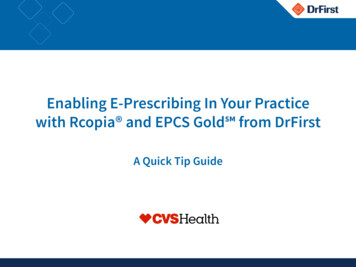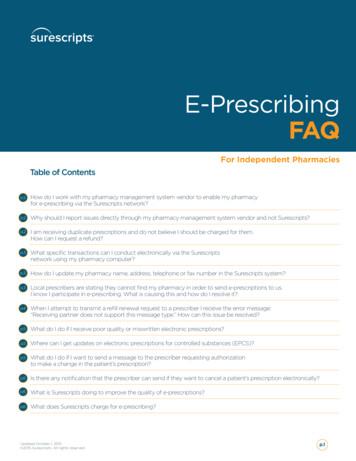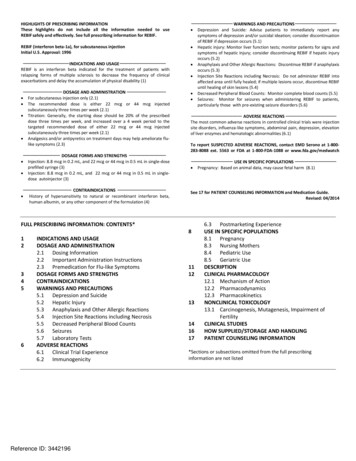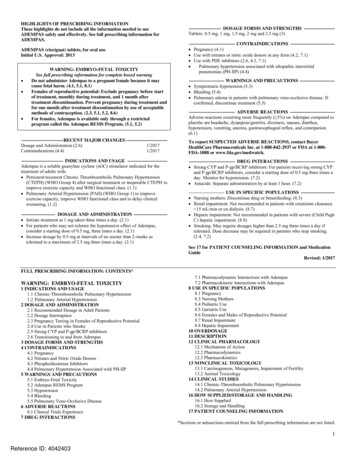
Transcription
HIGHLIGHTS OF PRESCRIBING INFORMATIONThese highlights do not include all the information needed to useADEMPAS safely and effectively. See full prescribing information forADEMPAS.ADEMPAS (riociguat) tablets, for oral useInitial U.S. Approval: 2013 WARNING: EMBRYO-FETAL TOXICITYSee full prescribing information for complete boxed warningDo not administer Adempas to a pregnant female because it maycause fetal harm. (4.1, 5.1, 8.1)Females of reproductive potential: Exclude pregnancy before startof treatment, monthly during treatment, and 1 month aftertreatment discontinuation. Prevent pregnancy during treatment andfor one month after treatment discontinuation by use of acceptablemethods of contraception. (2.3, 5.1, 5.2, 8.6)For females, Adempas is available only through a restrictedprogram called the Adempas REMS Program. (5.1, 5.2)--------------------- DOSAGE FORMS AND STRENGTHS ------------------- Tablets: 0.5 mg, 1 mg, 1.5 mg, 2 mg and 2.5 mg (3)------------------------------ CONTRAINDICATIONS ---------------------------- Pregnancy (4.1) Use with nitrates or nitric oxide donors in any form (4.2, 7.1) Use with PDE inhibitors (2.6, 4.3, 7.1) Pulmonary hypertension associated with idiopathic interstitialpneumonias (PH-IIP) (4.4)----------------------- WARNINGS AND PRECAUTIONS ---------------------- Symptomatic hypotension (5.3) Bleeding (5.4) Pulmonary edema in patients with pulmonary veno-occlusive disease. Ifconfirmed, discontinue treatment (5.5)------------------------------ ADVERSE REACTIONS ---------------------------- Adverse reactions occurring more frequently ( 3%) on Adempas compared toplacebo are headache, dyspepsia/gastritis, dizziness, nausea, diarrhea,hypotension, vomiting, anemia, gastroesophageal reflux, and T MAJOR CHANGES -------------------------- Dosage and Administration (2.6)1/2017Contraindications (4.4)1/2017To report SUSPECTED ADVERSE REACTIONS, contact BayerHealthCare Pharmaceuticals Inc. at 1-888-842-2937 or FDA at 1-800 FDA-1088 or www.fda.gov/medwatch.--------------------------- INDICATIONS AND USAGE -------------------------Adempas is a soluble guanylate cyclase (sGC) stimulator indicated for thetreatment of adults with: Persistent/recurrent Chronic Thromboembolic Pulmonary Hypertension(CTEPH) (WHO Group 4) after surgical treatment or inoperable CTEPH toimprove exercise capacity and WHO functional class. (1.1) Pulmonary Arterial Hypertension (PAH) (WHO Group 1) to improveexercise capacity, improve WHO functional class and to delay clinicalworsening. (1.2)------------------------------ DRUG INTERACTIONS ---------------------------- Strong CYP and P-gp/BCRP inhibitors: For patients receiving strong CYPand P-gp/BCRP inhibitors, consider a starting dose of 0.5 mg three times aday. Monitor for hypotension. (7.2) Antacids: Separate administration by at least 1 hour. (7.2)---------------------- DOSAGE AND ADMINISTRATION --------------------- Initiate treatment at 1 mg taken three times a day. (2.1) For patients who may not tolerate the hypotensive effect of Adempas,consider a starting dose of 0.5 mg, three times a day. (2.1) Increase dosage by 0.5 mg at intervals of no sooner than 2-weeks astolerated to a maximum of 2.5 mg three times a day. (2.1)----------------------- USE IN SPECIFIC POPULATIONS --------------------- Nursing mothers: Discontinue drug or breastfeeding. (8.3) Renal impairment: Not recommended in patients with creatinine clearance 15 mL/min or on dialysis. (8.7) Hepatic impairment: Not recommended in patients with severe (Child PughC) hepatic impairment. (8.8) Smoking: May require dosages higher than 2.5 mg three times a day iftolerated. Dose decrease may be required in patients who stop smoking.(2.4, 7.2)See 17 for PATIENT COUNSELING INFORMATION and MedicationGuideRevised: 1/2017FULL PRESCRIBING INFORMATION: CONTENTS*WARNING: EMBRYO-FETAL TOXICITY1 INDICATIONS AND USAGE1.1 Chronic-Thromboembolic Pulmonary Hypertension1.2 Pulmonary Arterial Hypertension2 DOSAGE AND ADMINISTRATION2.1 Recommended Dosage in Adult Patients2.2 Dosage Interruption2.3 Pregnancy Testing in Females of Reproductive Potential2.4 Use in Patients who Smoke2.5 Strong CYP and P-gp/BCRP inhibitors2.6 Transitioning to and from Adempas3 DOSAGE FORMS AND STRENGTHS4 CONTRAINDICATIONS4.1 Pregnancy4.2 Nitrates and Nitric Oxide Donors4.3 Phosphodiesterase Inhibitors4.4 Pulmonary Hypertension Associated with PH-IIP5 WARNINGS AND PRECAUTIONS5.1 Embryo-Fetal Toxicity5.2 Adempas REMS Program5.3 Hypotension5.4 Bleeding5.5 Pulmonary Veno-Occlusive Disease6 ADVERSE REACTIONS6.1 Clinical Trials Experience7 DRUG INTERACTIONS7.1 Pharmacodynamic Interactions with Adempas7.2 Pharmacokinetic Interactions with Adempas8 USE IN SPECIFIC POPULATIONS8.1 Pregnancy8.3 Nursing Mothers8.4 Pediatric Use8.5 Geriatric Use8.6 Females and Males of Reproductive Potential8.7 Renal Impairment8.8 Hepatic Impairment10 OVERDOSAGE11 DESCRIPTION12 CLINICAL PHARMACOLOGY12.1 Mechanism of Action12.2 Pharmacodynamics12.3 Pharmacokinetics13 NONCLINICAL TOXICOLOGY13.1 Carcinogenesis, Mutagenesis, Impairment of Fertility13.2 Animal Toxicology14 CLINICAL STUDIES14.1 Chronic-Thromboembolic Pulmonary Hypertension14.2 Pulmonary Arterial Hypertension16 HOW SUPPLIED/STORAGE AND HANDLING16.1 How Supplied16.2 Storage and Handling17 PATIENT COUNSELING INFORMATION*Sections or subsections omitted from the full prescribing information are not listed.1Reference ID: 4042403
FULL PRESCRIBING INFORMATIONWARNING: EMBRYO-FETAL TOXICITYDo not administer Adempas to a pregnant female because it may cause fetal harm [see Contraindications (4.1),Warnings and Precautions (5.1) and Use in Specific Populations (8.1)].Females of reproductive potential: Exclude pregnancy before the start of treatment, monthly during treatment,and 1 month after stopping treatment. Prevent pregnancy during treatment and for one month after stoppingtreatment by using acceptable methods of contraception [see Dosage and Administration (2.3), Warnings andPrecautions (5.1, 5.2),and Use in Specific Populations (8.6)].For all female patients, Adempas is available only through a restricted program called the Adempas RiskEvaluation and Mitigation Strategy (REMS) Program [see Warnings and Precautions (5.1, 5.2)].1 INDICATIONS AND USAGE1.1 Chronic-Thromboembolic Pulmonary HypertensionAdempas is indicated for the treatment of adults with persistent/recurrent chronic thromboembolic pulmonaryhypertension (CTEPH), (WHO Group 4) after surgical treatment, or inoperable CTEPH, to improve exercise capacity andWHO functional class [see Clinical Studies (14.1)].1.2 Pulmonary Arterial HypertensionAdempas is indicated for the treatment of adults with pulmonary arterial hypertension (PAH), (WHO Group 1), toimprove exercise capacity, WHO functional class and to delay clinical worsening.Efficacy was shown in patients on Adempas monotherapy or in combination with endothelin receptor antagonists orprostanoids. Studies establishing effectiveness included predominately patients with WHO functional class II–III andetiologies of idiopathic or heritable PAH (61%) or PAH associated with connective tissue diseases (25%) [see ClinicalStudies (14.2)].2 DOSAGE AND ADMINISTRATION2.1 Recommended Dosage in Adult PatientsThe recommended starting dosage is 1 mg taken 3 times a day. For patients who may not tolerate the hypotensive effect ofAdempas, consider a starting dose of 0.5 mg taken three times a day. If systolic blood pressure remains greater than 95mmHg and the patient has no signs or symptoms of hypotension, up-titrate the dose by 0.5 mg taken three times a day.Dose increases should be no sooner than 2 weeks apart. The dose can be increased to the highest tolerated dosage, up to amaximum of 2.5 mg taken three times a day. If at any time, the patient has symptoms of hypotension, decrease the dosageby 0.5 mg taken three times a day.2.2 Dosage InterruptionIf a dose is missed, advise patients to continue with the next regularly scheduled dose.In case Adempas is interrupted for 3 days or more, re-titrate Adempas.2.3 Pregnancy Testing in Females of Reproductive PotentialObtain pregnancy tests prior to initiation and monthly during treatment [see Use in Specific Populations (8.6)].2.4 Use in Patients who SmokeConsider titrating to dosages higher than 2.5 mg three times a day, if tolerated, in patients who smoke. A dose decreasemay be required in patients who stop smoking [see Drug Interactions (7.2) and Clinical Pharmacology (12.3)].2Reference ID: 4042403
2.5 Strong CYP and P-gp/BCRP InhibitorsConsider a starting dose of 0.5 mg, three times a day when initiating Adempas in patients receiving strong cytochromeP450 (CYP) and P-glycoprotein/breast cancer resistance protein (P-gp/BCRP) inhibitors such as azole antimycotics (forexample, ketoconazole, itraconazole) or HIV protease inhibitors (for example, ritonavir). Monitor for signs and symptomsof hypotension on initiation and on treatment with strong CYP and P-gp/BCRP inhibitors [see Warnings and Precautions(5.3), Drug Interactions (7.2) and Clinical Pharmacology (12.3)].2.6 Transitioning to and from Adempas Discontinue sildenafil at least 24 hours prior to administering Adempas [see Contraindications (4.3) and DrugInteractions (7)]. Discontinue tadalafil at least 48 hours prior to administering Adempas [see Contraindications (4.3) and DrugInteractions (7)]. Consider initiating Adempas at a starting dose of 0.5 mg in patients at risk of hypotension [seeDosage and Administration (2.1)]. It is recommended to monitor for signs and symptoms of hypotension on initiation. Discontinue Adempas at least 24 hours prior to administering a PDE5-inhibitor [see Dosage and Administration (2.1),Contraindications (4.3), and Drug Interactions (7)]. It is recommended to monitor for signs and symptoms ofhypotension on initiation.3 DOSAGE FORMS AND STRENGTHSTablets: film-coated, round, bi-convex: 0.5 mg, white, with “BAYER” cross on one side and “0.5” and “R” on the other side 1 mg, pale-yellow, with “BAYER” cross on one side and “1” and “R” on the other side 1.5 mg, yellow-orange, with “BAYER” cross on one side and “1.5” and “R” on the other side 2 mg, pale orange, with “BAYER” cross on one side and “2” and “R” on the other side 2.5 mg, red-orange, with “BAYER” cross on one side and “2.5” and “R” on the other side4 CONTRAINDICATIONS4.1 PregnancyAdempas may cause fetal harm when administered to a pregnant woman. Adempas is contraindicated in females who arepregnant. Adempas was consistently shown to have teratogenic effects when administered to animals. If this drug is usedduring pregnancy, or if the patient becomes pregnant while taking this drug, the patient should be apprised of the potentialhazard to the fetus [see Use in Specific Populations (8.1)].4.2 Nitrates and Nitric Oxide DonorsCo-administration of Adempas with nitrates or nitric oxide donors (such as amyl nitrite) in any form is contraindicated[see Drug Interactions (7.1) and Clinical Pharmacology (12.2)].4.3 Phosphodiesterase InhibitorsConcomitant administration of Adempas with specific PDE-5 inhibitors (such as sildenafil, tadalafil, or vardenafil) ornonspecific PDE inhibitors (such as dipyridamole or theophylline) is contraindicated [see Dosage and Administration(2.6), Drug Interactions (7.1) and Clinical Pharmacology (12.2)]. Do not administer within 24 hours of sildenafil. Do notadminister 24 hours before or within 48 hours after tadalafil.4.4 Pulmonary Hypertension Associated with Idiopathic Interstitial Pneumonias (PH-IIP)Adempas is contraindicated in patients with pulmonary hypertension associated with idiopathic interstitial pneumonias(PH-IIP).3Reference ID: 4042403
5 WARNINGS AND PRECAUTIONS5.1 Embryo-Fetal ToxicityAdempas may cause fetal harm when administered during pregnancy and is contraindicated for use in women who arepregnant. In females of reproductive potential, exclude pregnancy prior to initiation of therapy, advise use of acceptablecontraception and obtain monthly pregnancy tests. For females, Adempas is only available through a restricted programunder the Adempas REMS Program [see Dosage and Administration (2.3), Warnings and Precautions (5.2) and Use inSpecific Populations (8.1, 8.6)].5.2 Adempas REMS ProgramFemales can only receive Adempas through the Adempas Risk Evaluation and Mitigation Strategy (REMS) Program, arestricted distribution program [see Warnings and Precautions (5.1)].Important requirements of the Adempas REMS Program include the following: Prescribers must be certified with the program by enrolling and completing training. All females, regardless of reproductive potential, must enroll in the Adempas REMS Program prior to initiatingAdempas. Male patients are not enrolled in the Adempas REMS Program. Female patients of reproductive potential must comply with the pregnancy testing and contraception requirements[see Use in Specific Populations (8.6)]. Pharmacies must be certified with the program and must only dispense to patients who are authorized to receiveAdempas.Further information, including a list of certified pharmacies, is available at www.AdempasREMS.com or 1-855-4ADEMPAS.5.3 HypotensionAdempas reduces blood pressure. Consider the potential for symptomatic hypotension or ischemia in patients withhypovolemia, severe left ventricular outflow obstruction, resting hypotension, autonomic dysfunction, or concomitanttreatment with antihypertensives or strong CYP and P-gp/BCRP inhibitors [see Drug Interactions (7.2) and ClinicalPharmacology (12.3)]. Consider a dose reduction if patient develops signs or symptoms of hypotension.5.4 BleedingIn the placebo-controlled clinical trials, serious bleeding occurred in 2.4% of patients taking Adempas compared to 0% ofplacebo patients. Serious hemoptysis occurred in 5 (1%) patients taking Adempas compared to 0 placebo patients,including one event with fatal outcome. Serious hemorrhagic events also included 2 patients with vaginal hemorrhage, 2with catheter site hemorrhage, and 1 each with subdural hematoma, hematemesis, and intra-abdominal hemorrhage.5.5 Pulmonary Veno-Occlusive DiseasePulmonary vasodilators may significantly worsen the cardiovascular status of patients with pulmonary veno-occlusivedisease (PVOD). Therefore, administration of Adempas to such patients is not recommended. Should signs of pulmonaryedema occur, the possibility of associated PVOD should be considered and, if confirmed, discontinue treatment withAdempas.6 ADVERSE REACTIONSThe following serious adverse reactions are discussed elsewhere in the labeling: Embryo-Fetal Toxicity [see Warnings and Precautions (5.1)] Hypotension [see Warnings and Precautions (5.3)] Bleeding [see Warnings and Precautions (5.4)]4Reference ID: 4042403
6.1 Clinical Trials ExperienceBecause clinical trials are conducted under widely varying conditions, adverse reaction rates observed in the clinical trialsof a drug cannot be directly compared to rates in the clinical trials of another drug and may not reflect the rates observedin practice.The safety data described below reflect exposure to Adempas in two, randomized, double blind, placebo-controlled trialsin patients with inoperable or recurrent/persistent CTEPH (CHEST-1) and treatment naive or pre-treated PAH patients(PATENT-1). The population (Adempas: n 490; Placebo: n 214) was between the age of 18 and 80 years [see ClinicalStudies (14.1, 14.2)].The safety profile of Adempas in patients with inoperable or recurrent/persistent CTEPH (CHEST-1) and treatment naiveor pre-treated PAH (PATENT-1) were similar. Therefore, adverse drug reactions (ADRs) identified from the 12 and 16week placebo-controlled trials for PAH and CTEPH respectively were pooled, and those occurring more frequently onAdempas than placebo ( 3%) are displayed in Table 1 below. Most adverse reactions in Table 1 can be ascribed to thevasodilatory mechanism of action of Adempas.The overall rates of discontinuation due to an adverse event in the pivotal placebo-controlled trials were 2.9% forAdempas and 5.1% for placebo (pooled data).Table 1: Adverse Reactions Occurring More Frequently ( 3%) on Adempas than Placebo(Pooled from CHEST-1 and PATENT-1)Adverse ReactionsAdempas %(n 490)Placebo %(n 214)Headache2718Dyspepsia and tension104VomitingAnemia(including laboratory parameters)Gastroesophageal reflux diseaseConstipation107725521Other events that were seen more frequently in Adempas compared to placebo and potentially related to treatment were:palpitations, nasal congestion, epistaxis, dysphagia, abdominal distension and peripheral edema. With longer observationin uncontrolled long-term extension studies the safety profile was similar to that observed in the placebo controlled phase3 trials.7 DRUG INTERACTIONS7.1 Pharmacodynamic Interactions with AdempasNitrates: Co-administration of Adempas with nitrates or nitric oxide donors (such as amyl nitrite) in any form iscontraindicated because of hypotension [see Contraindications (4.2) and Clinical Pharmacology (12.2)].PDE Inhibitors: Co-administration of Adempas with specific PDE-5 inhibitors (such as sildenafil, tadalafil, or vardenafil)and nonspecific PDE inhibitors (such as dipyridamole or theophylline), is contraindicated because of hypotension. Do not5Reference ID: 4042403
administer within 24 hours of sildenafil. Do not administer 24 hours before or within 48 hours after tadalafil [see Dosageand Administration (2.6)]. Clinical experience with co-administration of Adempas and other phosphodiesterase inhibitors(for example, milrinone, cilostazole, roflumilast) is limited.7.2 Pharmacokinetic Interactions with AdempasSmoking: Plasma concentrations in smokers are reduced by 50% to 60% compared to nonsmokers. Based onpharmacokinetic modeling, for patients who are smokers, doses higher than 2.5 mg three times a day may be consideredin order to match exposure seen in nonsmoking patients. Safety and effectiveness of Adempas doses higher than 2.5 mgthree times a day have not been established. A dose reduction should be considered in patients who stop smoking [seeDosage and Administration (2.4) and Clinical Pharmacology (12.3)].Strong CYP and P-gp/BCRP inhibitors: Concomitant use of riociguat with strong cytochrome CYP inhibitors and Pgp/BCRP inhibitors such as azole antimycotics (for example, ketoconazole, itraconazole) or HIV protease inhibitors (suchas ritonavir) increase riociguat exposure and may result in hypotension. Consider a starting dose of 0.5 mg 3 times a daywhen initiating Adempas in patients receiving strong CYP and P-gp/BCRP inhibitors. Monitor for signs and symptoms ofhypotension on initiation and on treatment with strong CYP and P-gp/BCRP inhibitors. A dose reduction should beconsidered in patients who may not tolerate the hypotensive effect of riociguat [see Dosage and Administration (2.5),Warnings and Precautions (5.3) and Clinical Pharmacology (12.3)].Strong CYP3A inducers: Strong inducers of CYP3A (for example, rifampin, phenytoin, carbamazepine, phenobarbital orSt. John’s Wort) may significantly reduce riociguat exposure. Data are not available to guide dosing of riociguat whenstrong CYP3A inducers are co-administered [see Clinical Pharmacology (12.3)].Antacids: Antacids such as aluminum hydroxide/magnesium hydroxide decrease riociguat absorption and should not betaken within 1 hour of taking Adempas [see Clinical Pharmacology (12.3)].8 USE IN SPECIFIC POPULATIONS8.1 PregnancyPregnancy Category XRisk SummaryAdempas may cause fetal harm when administered to a pregnant woman and is contraindicated during pregnancy.Adempas was teratogenic and embryotoxic in rats at doses with exposures to unbound drug that were approximately 8times and 2 times, respectively, the human exposure. In rabbits, riociguat led to abortions at 4 times the human exposureand fetal toxicity with exposures approximately 13 times the human exposure. If Adempas is used in pregnancy, or if thepatient becomes pregnant while taking this drug, apprise the patient of the potential hazard to the fetus [see BoxedWarning and Contraindications (4.1)].Animal DataIn rats administered riociguat orally (1, 5, and 25 mg/kg/day) throughout organogenesis, an increased rate of cardiacventricular-septal defect was observed at the highest dose tested. The highest dose produced evidence of maternal toxicity(reduced body weight). Post-implantation loss was statistically significantly increased from the mid-dose of 5 mg/kg/day.Plasma exposure at the lowest dose in which no adverse effects were observed is approximately 0.4 times that in humansat the maximally recommended human dose (MRHD) of 2.5 mg three times a day based on area under the timeconcentration curve (AUC) for unbound drug in rat and humans. Plasma exposure at the highest dose (25 mg/kg/day) isapproximately 8 times that in humans at the MRHD while exposure at the mid-dose (5 mg/kg/day) is approximately 2times that in humans at the MRHD. In rabbits given doses of 0.5, 1.5 and 5 mg/kg/day, an increase in spontaneousabortions was observed starting at the middle dose of 1.5 mg/kg, and an increase in resorptions was observed at 5mg/kg/day. Plasma exposures at these doses were 4 times and 13 times, respectively, the human exposure at the MRHD.6Reference ID: 4042403
8.3 Nursing MothersIt is not known if Adempas is present in human milk. Riociguat or its metabolites were present in the milk of rats.Because many drugs are present in human milk and because of the potential for serious adverse reactions in nursinginfants from riociguat, discontinue nursing or Adempas.8.4 Pediatric UseSafety and effectiveness of Adempas in pediatric patients have not been established [see Nonclinical Toxicology (13.2)].8.5 Geriatric UseOf the total number of subjects in clinical studies of Adempas, 23% were 65 and over, and 6% were 75 and over [seeClinical Studies (14)]. No overall differences in safety or effectiveness were observed between these subjects and youngersubjects, and other reported clinical experience has not identified differences in responses between the elderly andyounger patients, but greater sensitivity of some older individuals cannot be ruled out.Elderly patients showed a higher exposure to Adempas [see Clinical Pharmacology (12.3)].8.6 Females and Males of Reproductive PotentialPregnancy Testing: Female patients of reproductive potential must have a negative pregnancy test prior to startingtreatment with Adempas, monthly during treatment, and one month after discontinuation of treatment with Adempas.Advise patients to contact their healthcare provider if they become pregnant or suspect they may be pregnant. Counselpatients on the risk to the fetus [see Boxed Warning, Dosage and Administration (2.3) and Use in Specific Populations(8.1)].Contraception: Female patients of reproductive potential must use acceptable methods of contraception during treatmentwith Adempas and for 1 month after treatment with Adempas. Patients may choose one highly effective form ofcontraception (intrauterine devices [IUD], contraceptive implants or tubal sterilization) or a combination of methods(hormone method with a barrier method or two barrier methods). If a partner’s vasectomy is the chosen method ofcontraception, a hormone or barrier method must be used along with this method. Counsel patients on pregnancy planningand prevention, including emergency contraception, or designate counseling by another healthcare provider trained incontraceptive counseling [see Boxed Warning].8.7 Renal ImpairmentSafety and efficacy have not been demonstrated in patients with creatinine clearance 15 mL/min or on dialysis [seeClinical Pharmacology (12.3)].8.8 Hepatic ImpairmentSafety and efficacy have not been demonstrated in patients with severe hepatic impairment (Child Pugh C) [see ClinicalPharmacology (12.3)].10 OVERDOSAGEIn cases of overdose, blood pressure should be closely monitored and supported as appropriate. Based on extensiveplasma protein binding, riociguat is not expected to be dialyzable.11 DESCRIPTIONAdempas (riociguat) is a tablet for oral administration. Riociguat is methyl 4,6-diamino-2-[1-(2-fluorobenzyl)-1Hpyrazolo e with the following structural formula:7Reference ID: 4042403
OH3CNH2NO CH3NH2NNNNNFC20H19FN8O2Riociguat is a white to yellowish, crystalline, non-hygroscopic substance with a molecular weight of 422.42 g/mol. Insolid form it is stable to temperature, light, and humidity.The solubility at 25 C in water: 4 mg/L, in ethanol: 800 mg/L, in 0.1 HCl (pH 1): 250 mg/L and in buffer (phosphate) pH7: 3 mg/L. In the pH range of 2 to 4 the solubility showed strong pH-dependency. Solubility increases at lower pH values.Each round film-coated tablet contains 0.5 mg (1.0, 1.5, 2.0, 2.5 mg) riociguat. The inactive ingredients are cellulosemicrocrystalline, crospovidone, hypromellose 5cP, lactose monohydrate, magnesium stearate, sodium laurylsulfate,hydroxypropylcellulose, hypromellose 3cP, propylene glycol, and titanium dioxide. Adempas 1, 1.5, 2, and 2.5 mg tabletscontain, in addition, ferric oxide yellow. Adempas 2 and 2.5 mg tablets contain, in addition, ferric oxide red.12 CLINICAL PHARMACOLOGY12.1 Mechanism of ActionRiociguat is a stimulator of soluble guanylate cyclase (sGC), an enzyme in the cardiopulmonary system and the receptorfor nitric oxide (NO).When NO binds to sGC, the enzyme catalyzes synthesis of the signaling molecule cyclic guanosine monophosphate(cGMP). Intracellular cGMP plays an important role in regulating processes that influence vascular tone, proliferation,fibrosis and inflammation.Pulmonary hypertension is associated with endothelial dysfunction, impaired synthesis of nitric oxide and insufficientstimulation of the NO-sGC-cGMP pathway.Riociguat has a dual mode of action. It sensitizes sGC to endogenous NO by stabilizing the NO-sGC binding. Riociguatalso directly stimulates sGC via a different binding site, independently of NO.Riociguat stimulates the NO-sGC-cGMP pathway and leads to increased generation of cGMP with subsequentvasodilation.The active metabolite (M1) of riociguat is 1/3 to 1/10 as potent as riociguat.12.2 PharmacodynamicsThere is a direct relationship between riociguat plasma concentration and hemodynamic parameters such as systemicvascular resistance, systolic blood pressure, pulmonary vascular resistance (PVR), and cardiac output [see Clinical Studies(14)].Hemodynamic parameters were assessed in CTEPH patients in CHEST-1 [see Clinical Studies (14.1)]. Right heartcatheterization was performed at the beginning and the end of the study period in 233 patients. A statistically significantreduction of PVR (-246 dyn*s*cm-5) was shown in the Adempas group vs. placebo. Improvements in other hemodynamicparameters (not pre-specified as endpoints) are displayed in Table 2 below.8Reference ID: 4042403
Table 2: CHEST-1, Change In Hemodynamic Parameters from Baseline to Last Visit (Individual DoseTitration to Maximum 2.5 mg Three Times a Day versus placebo)Parameter (unit)Mean changeLS meandifference95% CIAdempasPlaceboPulmonary Capillary Wedge Pressure(mmHg)0.590.180.58–0.36 to 1.53Right Atrial Pressure (mmHg)–1.04–0.55–0.55–1.72 to 0.62Pulmonary Arterial PressureSystolic (mmHg)–6.840.95–7.52–10.88 to –4.16Pulmonary Arterial PressureDiastolic (mmHg)–3.050.67–3.62–5.30 to –1.95Pulmonary Arterial PressureMean (mmHg)–4.310.76–4.96–6.75 to –3.16Mean Arterial Pressure (mmHg)–9.27–0.29–9.15–11.83 to –6.46Mixed Venous Oxygen Saturation (%)2.95–0.443.851.46 to 6.25Cardiac Output (L/min)0.81–0.030.860.59 to 1.12Cardiac Index (L/min/m2)0.45–0.010.470.33 to 0.62Pulmonary Vascular Resistance(dyn*s*cm-5)–22623.1–246–303 to –190Pulmonary Vascular Resistance Index(dyn*s*cm-5*m2)–39748.3–449–554 to –344Systemic Vascular Resistance(dyn*s*cm-5)–44516.6–478–602 to –354Systemic Vascular Resistance Index(dyn*s*cm-5*m2)–79953.7–914–1141 to –687Hemodynamic parameters were assessed in PAH patients in PATENT-1 [see Clinical Studies (14.2)]. Right heartcatheterization was performed at the beginning and the end of the study period in 339 patients.A statistically significant reduction of PVR (-226 dyn*sec*cm-5) was shown in the Adempas individual titration group (tomaximum dose of 2.5 mg three times a day) vs. placebo. Improvement in other relevant hemodynamic parameters (notpre-specified as endpoints) for the individual dose titration group versus placebo are displayed in Table 3.9Reference ID: 4042403
Table 3: PATENT-1, Change in Hemodynamic Parameters from Baseline to Last Visit (Individual DoseTitration to Maximum 2.5 mg Three Times a Day versus Placebo)Parameter (unit)Mean changeLS meandifference95% CIAdempasPlaceboPulmonary Capillary Wedge Pressure(mmHg)1.080.460.41–0.36 to 1.18Right Atrial Pressure (mmHg)–0.200.97–1.01–2.15 to 0.13Pulmonary Arterial PressureSystolic (mmHg)–5.390.78–6.73–9.43 to –4.04Pulmonary Arterial Pressure Diastolic(mmHg)–3.19–1.12–2.41–4.15 to –0.68Pulmonary Arterial Pressuremean (mmHg)–3.93–0.5–3.83–5.61 to –2.06Mean Arterial Pressure (mmHg)–8.54–1.4–7.25–9.6 to –4.90Mixed Venous Oxygen Saturation (%)3.15–2.335.023.2 to 6.84Cardiac Output (L/min)0.93–0.010.930.7 to 1.15Cardiac Index (L/min/m )0.54–0.020.560.44 to 0.69Pulmonary Vascular Resistance(dyn*s*cm-5)–223–8.9–226–281 to –170Pulmonary Vascular Resistance Index(dyn*s*cm-5*m2)–374–22.4–377–469 to –285Systemic Vascular Resistance(dyn*s*cm-5)–448–67.5–395–473 to –316Systemic Vascular Resistance Index(dyn*s*cm-5*m2)–753–130–675–801 to –5502BiomarkersIn the CHEST-1 study, Adempas significantly reduced N-terminal prohormone of brain natriuretic peptide (NT-proBNP),placebo-corrected mean change from baseline -444 ng/L, 95% CI -843 to -45. In the PATENT-1 study Adempasdemonstrated a statistically significant reduction of NT-proBNP, placebo-corrected mean change from baseline: 432 ng/L, 9
2.5 . Strong CYP and P -gp/BCRP Inhibitors . Consider a starting dose of 0.5 mg, three times a day when initiating Adempas in patients receiving strong cytochrome

